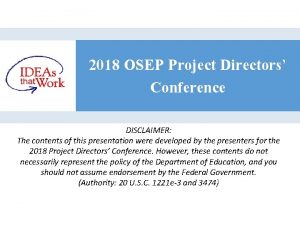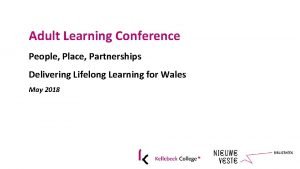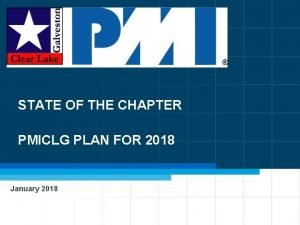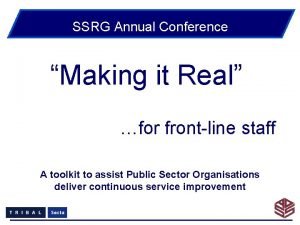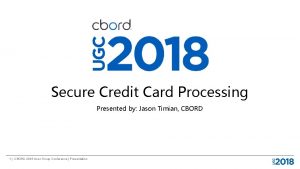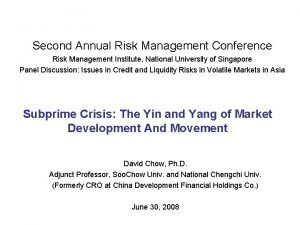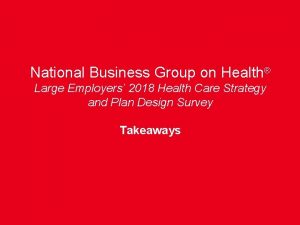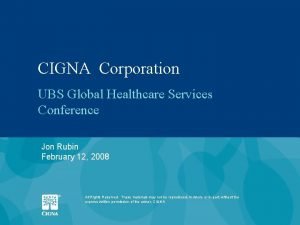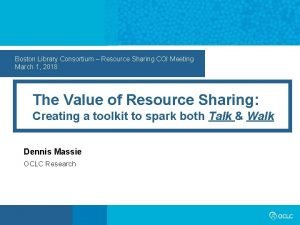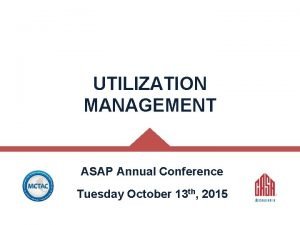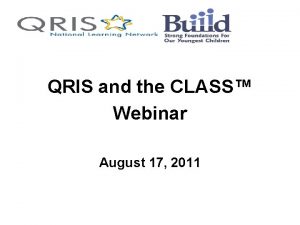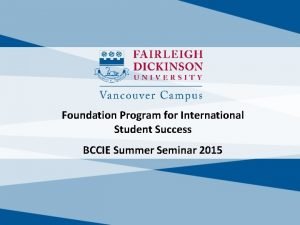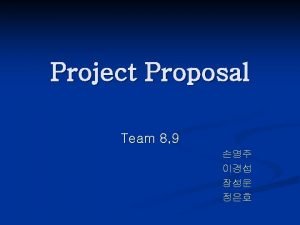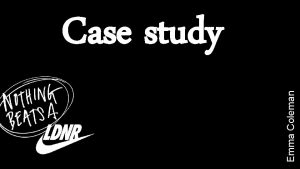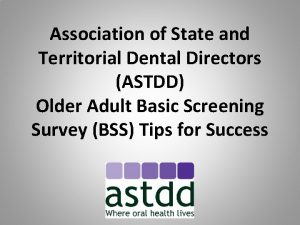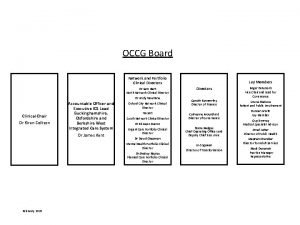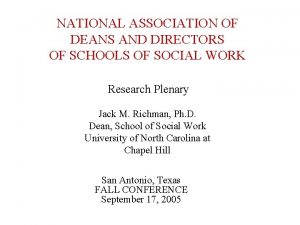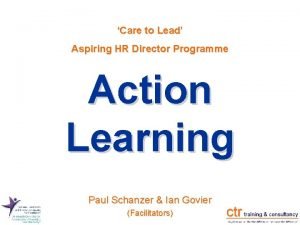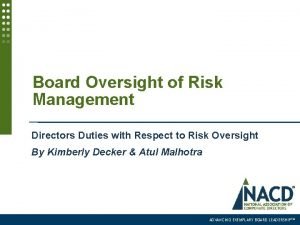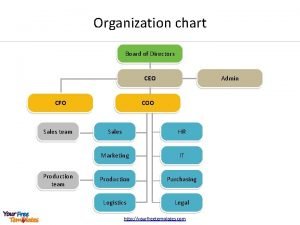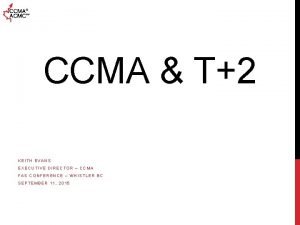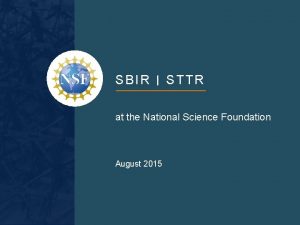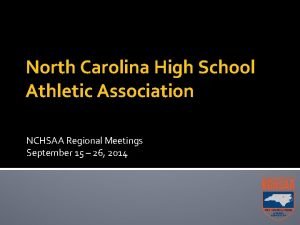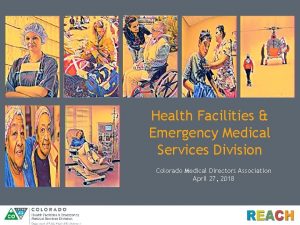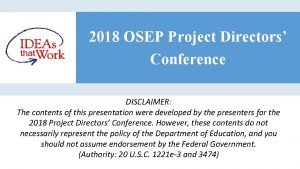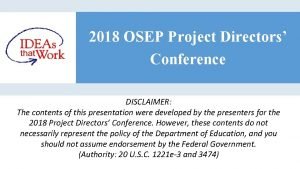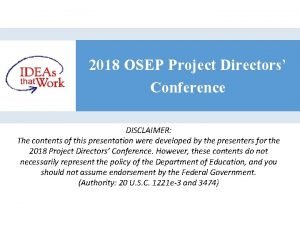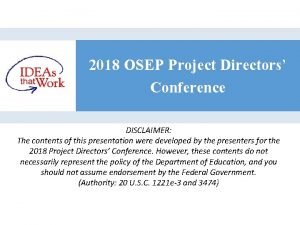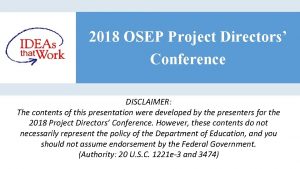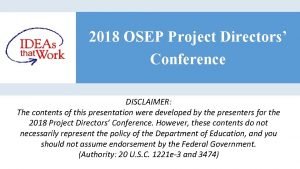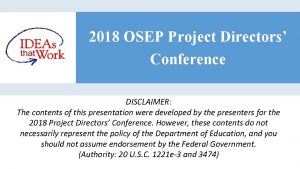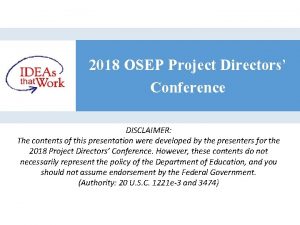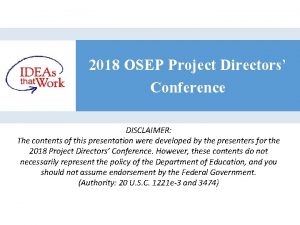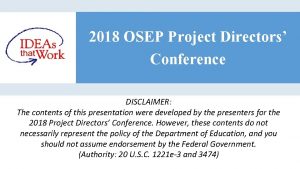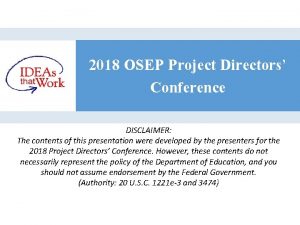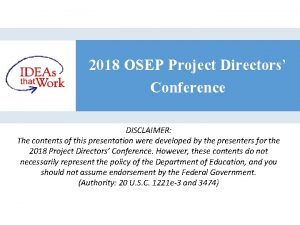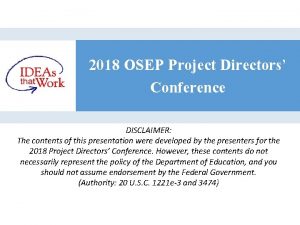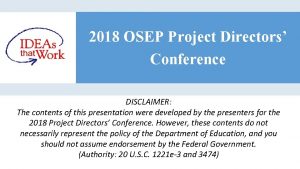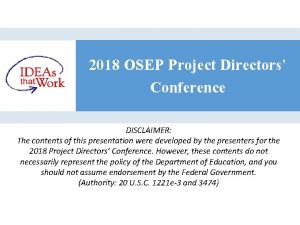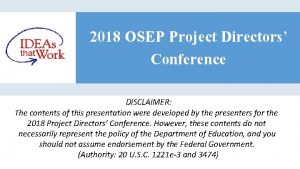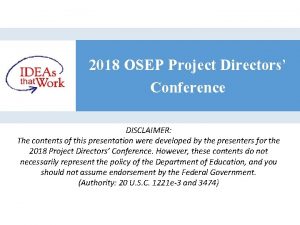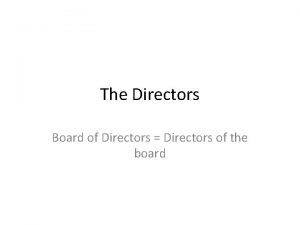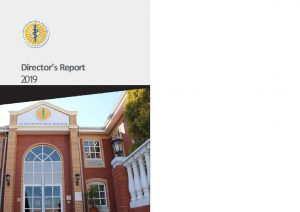2018 OSEP Project Directors Conference DISCLAIMER The contents



























































- Slides: 59

2018 OSEP Project Directors’ Conference DISCLAIMER: The contents of this presentation were developed by the presenters for the 2018 Project Directors’ Conference. However, these contents do not necessarily represent the policy of the Department of Education, and you should not assume endorsement by the Federal Government. (Authority: 20 U. S. C. 1221 e-3 and 3474)

Keeping Students in School: Minimizing Time Away from Instruction and Increasing Attendance Panelists: Rob Horner Steve Goodman Bill Bixby Sheila Huckestein Moderator: George Sugai University of Oregon Mi. Blsi, Michigan Prince William County, Virginia University of Connecticut

Objectives Define the Problem of Discipline Systems that remove students from access to instruction: A major issue for students with disabilities Define core elements of effective solutions Describe an effective example from the State perspective (Mi. BLSi) Describe an effective example from the District perspective (Prince William County) Describe an effective example from the School perspective (Prince William County) Discussion about existing options, research needs, implementation implications

Access to instruction Access to effective instruction is an under-monitored and underappreciated variable affecting the success of schools Variables affecting academic engagement and access to instruction Quality and match of curriculum and instructional practices Discipline systems Attendance systems Data collection… and use of data for decision-making State and district policy and priority setting

Increasing attendance and instructional time Policy Decisions Data Systems: Monitor time in instruction at the classroom, school and district levels Priority: Invest in professional development, early identification, adaptation Practices Invest in prevention, proactive support, school-wide social climate, Instructional discipline systems Attendance support

Protective Factors (high school) Students who feel connected to their school are also more likely to have better academic achievement, including higher grades and test scores, have better school attendance, and stay in school longer. Students who have key knowledge and skills used in the school setting are more successful. Studies show that positive relationships with teachers and staff in high school can greatly impact the academic achievement of students. Engagement can be enhanced through positive relationships with older peers; peer leaders 1 -2 years older can facilitate social and academic development as these peers understand the rules and develop positive strategies to overcome issues or problems.

School-wide Behavior Support Missouri Emphasis on role of school-wide systems for students with disabilities

Tim Lewis: Missouri Academic Proficiency with implementation of School-wide Behavior Support (PBIS)

Additional Impact of PBIS: Students on IEPs Schools implementing PBIS with fidelity have a lower mean percentage of students with IEPs Students with IEPs attending schools participating in PBIS have a higher average attendance rate On average, more students with disabilities spend 80% or more of their educational day in inclusive settings in schools participating in PBIS Missouri SW-PBIS, 2017

District Data Report: Solutions start with accurate Information High Schools: One urban district in the Western half of US

ODR Risk Ratio by High School: rate Balboa HS (#439) # ODRs / # of Students Wells (Ida B) HS (#743) Lincoln (Abraham) HS (#405) Burton (Phillip and Sala) HS (#764) Marshall (Thurgood) HS (#853) Washington (George) HS (#571) The Academy - San Francisco @ Mc. Ateer HS (#832) O'Connell (John) HS (#651) Mission HS (#725) Wallenberg (Raoul) HS (#785) Galileo HS (#559) Downtown HS (#742) SF International HS (#621) 0 0. 002 0. 004 0. 006 0. 008 0. 012

Top 10 Students Referred: One High School count Joaquin Powell-Smith 13 Cierra Fisher 7 Daryae Gibson 6 Netty La 6 Alasia Daniels 5 Deandre Cooper 5 Taurice Dillard 5 Robin Contreras De Leon 5 Adaiya Sanders 5 Pablo Santos-Kay 4 0 2 4 6 8 # of referrals 10 12 14

Instructional Minutes Lost: Top Ten Students minutes_lost Joaquin Powell-Smith 265 Cierra Fisher 260 Walter Chilel Lope 190 Sincere Green 138 Cianna Fisher 135 Jose Perez 120 Josue Andrade 120 Marcus Mc. Kinley 105 Kevin Medrano Funes 100 Deandre Cooper 100 0 50 100 150 200 Instructional Minutes Lost 250 300

Instructional Minutes Lost: Top Ten Referrers minutes_lost Razan Jabaji Arnoldo Zelaya 900 380 Resa Garcia 320 Adriana Camargo 165 Juan Garcia 145 David Stephens 135 Richard Moore 125 David Costanza 122 Karen Bioski-Simon 120 Jenny Bowman 120 0 200 400 600 Instructional Minutes Lost 800 1, 000

Instructional Minutes Lost by Ethnicity Black Latino Unknown White Chinese Samoan Asian Hawaiian Native American Declined to State Filipino Vietnamese Cambodian Other minutes_lost 2, 981 2, 715 265 236 200 180 158 127 106 98 41 20 10 0 0 500 1, 000 1, 500 2, 000 2, 500 3, 000 3, 500

Improving Discipline Systems: Instructional Suspension Learning Alternative (ISLA) Rhonda Nese, Ph. D University of Oregon

Student sent out of class for problem behavior: Goes to office with referral in hand & an academic assignment Triage: Is the behavior a safety concern? Yes No Administrator Response: Admin does studentguided FBA, reintegration plan w/ CICO, parent meeting, behavior contract, safety plan, modified schedule, detention, suspension Is the student calm, cooperative, and/or wanting to go back to class? Yes No ISLA: 1)Student-guided FBA, 2) Rehearsal of appropriate responses, 3) reintegration plan with rehearsal, 4) Transition back to class with a restorative chat OR restorative card filled out and placed in teacher’s mailbox Administrator Response: Admin does studentguided FBA, reintegration plan w/ CICO, parent meeting, behavior contract, safety plan, modified schedule, detention, suspension Academic supports on completing an assignment

ISLA Pilot Study Nese (2016) 1 Year pilot in 2 Middle Schools with high levels of exclusion Training for Teachers: PBIS in the classroom System for responding to behaviors When/why/how to send a student out Training for Paras: Triage process for students sent to the office Behavioral and academic supports for students Reconnection process for getting students back to class Training for Admin: Clarifying triage process How to handle major ODRs How to process OSS when returning to school

School #1: Referral Rate

School #1: Exclusion Rate

School #2: Referral Rate

School #2: Exclusion Rate

Minutes of Lost Instruction

Summary Access to Instruction Matters For ALL students, but especially for students with disabilities Key “Systems” affecting access to instruction Quality and match of curriculum and instructional practices Discipline systems Attendance systems Data collection… and use of data for decision-making State and district policy and priority setting

Example from Michigan Steve Goodman sgoodman@miblsimtss. org July 23, 2018 miblsi. org

Michigan’s Integrated Behavior and Learning Support Initiative (MIBLSI) MIBLSI is an intensive technical assistance program for the implementation of an integrated reading and behavior multi-tier system of support (MTSS) model that focuses on researchbased practices in reading, behavior and implementation science to ensure sustainability and scalability Partially funded through: Office of Special Education Programs: State Personnel Development Grant Office of Safe and Healthy Students: School Climate Transformation Grant

A Multi-Tier Framework Needs to incorporate… Efficient allocation of limited organizational resources to address student need Intensity of supports with interventions linked directly to functional assessment of problem Structures to ensure staff implement practices with fidelity

Addressing Chronic Absenteeism

Possible Contributing Factors for Chronic Absenteeism Possible Influencing contexts Factors contributing to Absenteeism School Family Community Avoid uninteresting or engaging instruction X Deficit academic skills leads to avoiding instruction X Avoid fear regarding lack of security (e. g. , not feeling safe) X Avoid bullying behavior X X Obtain peer rewards for truancy X X Lack of communication regarding absenteeism X X Lack of Transportation X X X Poor healthcare (e. g. , untreated asthma) X X Poor mental health care (e. g. , untreated anxiety) X X Providing care for siblings (bring funds to family) X Poor routine to wake up, get ready, and go to school X Unsafe Pathways to school X

Academic and Behavior MTSS: Addressing Improving Access to Instruction Impact on Educators Impact on Students Effective Academic Instruction • Increase effective instruction to address needs of all students • Increases competent academic skills and academic performance • Increases likelihood of finding instruction rewarding • Reduces avoidance behaviors Effective School Climates • Increase behavior support to create positive learning environments • Provide educators skills to prevent discipline problems and also alternative to exclusionary disciplinary practices • Increase prosocial behaviors • Increases likelihood of finding schools rewarding • Reduces avoidance behaviors

Why is academic and behavior MTSS important? • Quality instruction can reduce student engagement in problem behaviors (Filter & Horner, 2009; Preciado, Horner, Scott, & Baker, 2009, Sanford, 2006) • Implementation of schoolwide positive behavior support leads to increased academic time and enhanced academic outcomes (Algozzine & Algozzine, 2007; Horner et al. , 2009; Lassen, Steele, & Sailor, 2006) Children who fall behind academically will be more likely to find academic work aversive and also find escape-maintained problem behaviors reinforcing (Mc. Intosh, 2008; Mc. Intosh, Sadler, & Brown, 2010)

Benefits of PBIS/MTSS to address chronic absenteeism Multi-tier framework used to effectively and efficiently provide supports Problem solving based on data (for intervention planning and continuous improvement) Many contributing factors of chronic absenteeism are directly addressed by schools Focus on systems to ensure fidelity and sustainable implementation

Differentiation for Younger vs. Older Students Younger- more emphasis on supporting families for child to attend school Older- increased emphasis on supporting student to attend school

Cascading Model of Support MIBLSI provides technical assistance and support to develop effective systems, practices based on research and evaluation for continuous improvement. An aligned, integrated and compensatory system is created along a continuum from students, school staff, school leadership team, LEA leadership team, and ISD leadership team.

Framework for Addressing Practice and Supports The contextual focus of educational practices and the supporting infrastructure varies based on the level of the system. For example, at the classroom and grade level the focus on practices is high given they are closest to the students the “receivers. ” As the level of the system moves from the school, district, region, and country the focus of support increases while the focus on educational practices diminishes.

Example Outcomes

Regional Example Genesee Intermediate School District (ISD) supports PBIS implementation in 17 LEAs and 75 schools within their region. Genesee ISD’s capacity assessment results improved from 52% (2016) to 71% (2017). During this time, the average fidelity score for the schools in Genesee ISD is 68% on tier 1 with 46 schools achieving fidelity criteria on tier 1. Schools implementing PBIS from Spring 2016 to Spring 2017 have demonstrated a reduction of 914 days of suspensions for students with disabilities (or just over 5 years based upon 180 school days/year).


Reducing disproportionate discipline: Monthly referral rates by race (middle school)

Increasing access to instruction Ensure that effective instruction is provided Develop positive school climate so students feel more connected, engaged and ready to learn Address Interfering student behavior Preventing and addressing behavior problem that competes with instruction Providing alternatives to exclusionary discipline practices Addressing attendance problems through tiered logic

Reducing Exclusionary Discipline Rates and Gaps: Our First Year Journey Year at the Middle Level and Saunders Middle School William G. Bixby, Associate Superintendent for Middle Schools Dr. Sheila L. Huckestein, Principal, Saunders Middle School

Where is Prince William County? 42

Who Are We? Second largest school division in Virginia 35 th largest in the nation Site-based school division 90 schools and education centers Student enrollment of 89, 861 Majority-minority student population English learners (EL) are 26% of student population Economically disadvantage students are 45% of student population Our students come from over 121 countries and speak 144 world languages Major translation languages are Spanish, Urdu, Arabic, Vietnamese, and Korean 43

Why Address Exclusionary Discipline? Prince William County Public Schools Strategic Plan FY 2016 -20 GOAL 2: CLIMATE The teaching, learning, and working environment is safe, caring, healthy, and values human diversity. Objective 2. 2: Promote and ensure safe, responsible, and healthy behavior. 2. 2. 1 Increase positive behavior supports such that the disproportionate numbers of discipline referrals for economically disadvantaged students, limited English proficient students, students with disabilities, and students from each racial/ethnic category will decrease Divisionwide. 44

How Did We Begin Our Journey? Division team attended VDOE July 2017 Institute, “Classrooms, Not Courtrooms. ” Annual Summer Middle School Conference (August 2017) Each middle school formed a team of administrators and staff interested in improving student behavior Comprehensive student discipline and satisfaction survey data compiled for each school 45

How Did We Support Our Principals? Time: Middle School Conference Focus: Emphasis on school level problem solving to meet individual school level priorities and developing their target strategies. Professional Learning: Data analysis, resource mapping, best practices, and school plan development. Additional opportunities provided or supported during school year. Collaboration: Time with other schools, CEIS/PBIS, special education, and EL staff present at the conference Monitoring: Reduction of exclusionary discipline, disproportionality, and implementation of targeted strategies included in each principal’s annual professional growth plan. 46

Exclusionary Discipline Percentages by Student Group, 2016 -17 to 2017 -18 Student Group 2016 -17 2017 -18 % Change All 8. 67 6. 65 23% Reduction EL 9. 83 6. 98 29%Reduction Students with Disabilities Two or More Races 16. 20 13. 47 17% Reduction 9. 17 6. 93 24% Reduction Asian 2. 78 2. 49 10% Reduction Black 14. 23 11. 06 22% Reduction Hispanic 9. 79 7. 03 28% Reduction White 5. 22 4. 16 20% Reduction 47

Results: Reduction in Exclusionary Discipline Reductions across all student groups 425 fewer total students 60 fewer students with disabilities 123 fewer black students 13 of 18 schools showed reductions for all students 14 of 18 schools showed reductions for black students 9 of 18 schools showed reductions for students with disabilities 48

Exclusionary Discipline Disproportionality 2016 -17 to 2017 -18 Student Group Comparison White/Black 2016 -17 2017 -18 % Change 9. 01% 6. 90% 23% Reduction White/Hispanic 4. 57% 2. 87% 37% Reduction EL/Non-EL 1. 60% . 46% 77% Reduction Students with Disabilities/Students without Disabilities 8. 68% 7. 78% 10% Reduction 49

Locations of Exclusionary Discipline Violations, 2016 -17 to 2017 -18 Location During Class Change Transit to or from School 2016 -17 2133 498 347 2017 -18 1569 432 179 % Change 26% Reduction 13% Reduction 48% Reduction Lunch 209 140 33% Reduction School Sponsored Activity 92 49 47% Reduction 50

Top Five Primary Exclusionary Violations, 2016 -17 to 2017 -18 Primary Violation 2016 -17 2017 -18 Altercation/Confrontation 500 358 Disrespect/Walking Away 361 226 % Change 28% Reduction 33% Reduction 8% Reduction Fighting/No/Minor Injury/Mutual Participation 359 331 Classroom/Campus Disruption 358 296 Defiance/Refuse Request 351 238 51 17% Reduction 32% Reduction

Lessons Learned and Next Steps Continued focus on exclusionary disproportionality Improved communication with staff and all parents Fidelity of implementation Increased opportunities for school leaders to collaborate Avoid losing individual school trends within division trends Continue to focus on the data Middle School Summer Conference on August 8 will continue our focus on this journey 52

Three-Year Exclusionary Data Trends Saunders Middle School, PWCPS Student Subgroup 2014 -15 2015 -16 2016 -17 All 9. 38% 9. 50% 10. 08% White 4. 92% 6. 03% 6. 70% Black 15. 38% 16. 55% 16. 56% Hispanic 14. 84% 12. 20% 13. 29% Special Education 17. 42% 22. 78% 22. 22% 53

Root Cause Analysis Saunders Middle School, PWCPS Unilateral approach to disciplining consequences; Students are lagging in certain social skill sets; We are not helping students to improve their lagging skill(s), only giving consequences; and There are stagnant results in exclusionary discipline due to the ‘fixed mindset, ’ which is outdated. 54

New Approaches…New Results Saunders Middle School, PWCPS Collaborative approaches during the 2017 -18 school year: Workshops for students and parents Implementation of new BYOD policy taught by students Quarterly celebrations for good choices Self-reflections to help with students’ perspectives Lagging skills training for students Collaboration with students, parents, staff Eliminated exclusionary discipline 55

Closing the Gap in Exclusionary Discipline Saunders Middle School, PWCPS Saunders MS Exclusionary Discipline Count by Race/Ethnicity Total Comparative Count Through MP 3 64 50 45 18 14 2 6 9 4 2016 -17 2 or More Races 3 0 5 0 2017 -18 American Indian/Alaska Native Asian Black Hispanic of any Race 56 Native Hawaiian/Other Pacific White 3

It’s a WE Thing… Saunders Middle School, PWCPS Dr. Huckestein conducting a conflict resolution workshop with two eighth-grade students. “I really like the workshops because I wasn’t getting suspended and we get to talk it out and hear what she is feeling and the hate would still be brewing if we were suspended. ” 8 th Grade Student “It taught me to make better choices” 7 th Grade Student “It was amazing, it shows you what to not do on the internet and decisions you should make and apps you should not use” 7 th Grade Student “I completely agree and appreciate you taking the time to do this” 7 th Grade Parent “Thank you so much for teaching my son the dangers of vaping” 8 th Grade Parent “I think what we are doing will benefit the kids in the long run” Staff Member 57

References Flannery, Mary. “Report: Time to End Harmful, Exclusionary School Discipline Policies. ” NEA Today, 10 Nov. 2014, neatoday. org/2014/06/03/report-time-to-endharmful-exclusionary-school-discipline-policies/. Gladwell, Malcolm (2013). Outliers: The Story of Success. New York, NY: Back Bay Books/Little, Brown and Company. Greene, Ross. (2017, October). Lives in the Balance: Stay the Course”. Presented at the 7 th Annual Summit on Collaborative and Proactive Solutions Conference, Portland, ME. Greene, Ross (2014). Lost At School: Why Our Kids with Behavioral Challenges Are Falling Through the Cracks and How We Can Help Them. New York, NY: Scribner. Murgo, Joseph (2018). Building Bridges: Reducing Exclusionary Discipline by Implementing Alternative Practices that Involve all Stakeholders. Assistant Principal Academy, Prince William County Public Schools. 58

2018 OSEP Project Directors’ Conference DISCLAIMER: The contents of this presentation were developed by the presenters for the 2018 Project Directors’ Conference. However, these contents do not necessarily represent the policy of the Department of Education, and you should not assume endorsement by the Federal Government. (Authority: 20 U. S. C. 1221 e-3 and 3474)
 Osep syllabus
Osep syllabus Osep leak
Osep leak Dada la siguiente secuencia rusia 2018 rusia 2018
Dada la siguiente secuencia rusia 2018 rusia 2018 Gartner bi summit 2016
Gartner bi summit 2016 Annual fuze conference
Annual fuze conference Cmaa conference 2018
Cmaa conference 2018 Asha conference 2018 boston
Asha conference 2018 boston Workforce planning conference 2018
Workforce planning conference 2018 Lifelong learning conference 2018
Lifelong learning conference 2018 Pmi houston chapter
Pmi houston chapter Adss conference 2018
Adss conference 2018 Elavon msp conference 2018
Elavon msp conference 2018 Financial risk management conference 2018
Financial risk management conference 2018 National business group on health conference 2018
National business group on health conference 2018 Pfa conference 2018
Pfa conference 2018 Cigna conference 2018
Cigna conference 2018 Aatb conference 2018
Aatb conference 2018 Eacs conference 2018
Eacs conference 2018 Pat lincourt oasas
Pat lincourt oasas Interact conference 2018 teachstone
Interact conference 2018 teachstone Bccie summer conference 2018
Bccie summer conference 2018 Tlffra conference 2018
Tlffra conference 2018 Cfla conference 2018
Cfla conference 2018 Table of contents in project proposal
Table of contents in project proposal Examples of meta directors
Examples of meta directors Cyber security board of directors presentation
Cyber security board of directors presentation Namata board of directors
Namata board of directors Directors brief
Directors brief Jmh board of directors
Jmh board of directors Directors emma wolverson
Directors emma wolverson Board of directors compliance training
Board of directors compliance training Kpmg board of directors
Kpmg board of directors Association of state and territorial dental directors
Association of state and territorial dental directors German expressionist directors
German expressionist directors Clinical directors network
Clinical directors network National association of deans and directors
National association of deans and directors Chantal gaemperle linkedin
Chantal gaemperle linkedin Aspiring directors programme
Aspiring directors programme Board of directors risk oversight responsibilities
Board of directors risk oversight responsibilities Thai institute of directors association
Thai institute of directors association Npc board of directors
Npc board of directors Perfectionist directors
Perfectionist directors Chief growth officer org chart
Chief growth officer org chart Classification of directors
Classification of directors Perfectionist directors
Perfectionist directors Introduction to hospitality 7th edition
Introduction to hospitality 7th edition Shift together
Shift together Westinghouse board of directors
Westinghouse board of directors Section 11 company directors disqualification act
Section 11 company directors disqualification act Welcome 2 directors
Welcome 2 directors Ccma board of directors
Ccma board of directors Ieee board of directors
Ieee board of directors Nsf sbir program directors
Nsf sbir program directors North carolina athletic association
North carolina athletic association National association of state medicaid directors
National association of state medicaid directors Colorado medical directors association
Colorado medical directors association Robert burgess undertaker
Robert burgess undertaker Hát kết hợp bộ gõ cơ thể
Hát kết hợp bộ gõ cơ thể Ng-html
Ng-html Bổ thể
Bổ thể
